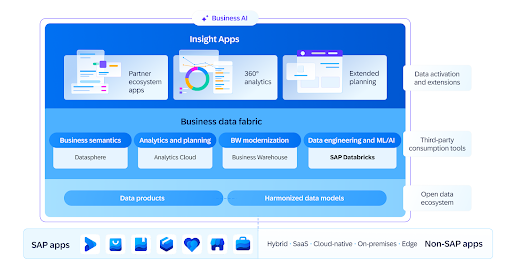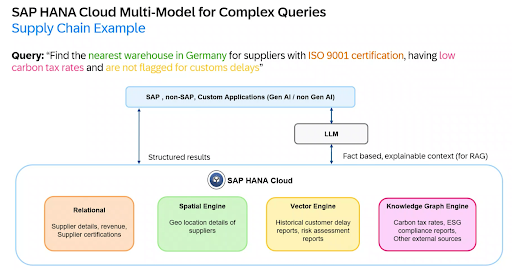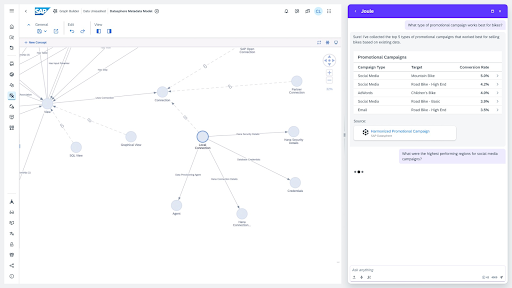This blog is the fifth (and final) in a series dedicated to exploring the role of SAP’s Business Technology Platform (BTP) from an Enterprise Architect’s perspective.
The second entry, titled, “How SAP BTP Empowers Business Capabilities & Drives Value Across the Enterprise”, introduced concepts of BTP in the context of Business Architecture.
This blog explores the concepts of enterprise data, analytics and AI within BTP’s data-focused products and services.
Introduction: Why Data Architecture Is Strategic for the Enterprise Architect
In today’s digital enterprise, data is the foundation of competitive advantage. Whether powering real-time decision-making, enabling machine learning models, or fueling predictive analytics, data must be accessible, trustworthy, secure, and business-ready.
For Enterprise Architects (EAs), this means more than just data storage—it’s about designing a strategic data architecture that allows the enterprise to:
- Aggregate SAP and non-SAP data
- Maintain business context and semantics
- Enable AI, reporting, and real-time insights
- Comply with data governance and security policies
SAP Business Technology Platform (BTP), through its most recent evolution with the announcement of SAP Business Data Cloud (BDC), which is built on BTP, gives enterprise architects the tools to realize this vision. BDC is a key component of SAP’s new data strategy, and it’s designed to help organizations unify, simplify, and operationalize enterprise data at scale.
In this blog, we’ll explore how SAP BTP and BDC support the EA’s mission across five key capabilities:
- Unified, real-time data access across enterprise systems
- Business-context-aware analytics
- AI readiness with clean, trusted data
- End-to-end governance and compliance
- Cost-efficient scalability and openness in hybrid/multi-cloud environments
Introducing SAP Business Data Cloud: The Next Evolution of SAP’s Data Product Strategy
SAP Business Data Cloud (BDC) is SAP’s answer to a persistent enterprise challenge: how to unify data from SAP and non-SAP sources while preserving business context.
SAP Business Data Cloud is a Software-as-a-Service solution equipped with data and analytics services needed in a modern world. Together with SAP BTP providing foundational services, SAP Business Data Cloud combines strategic solutions such as SAP HANA Cloud, SAP Datasphere, and SAP Analytics Cloud and their capabilities in one solution.

Traditional data lake strategies (on platforms like Azure Data Lake, AWS S3, or Google Cloud Storage) often focus on raw storage, but they strip away the relationships, hierarchies, and semantics that SAP systems provide. As a result, companies spend up to 80% of analytics project time rebuilding lost business context. BDC changes that.
Core Value Propositions of SAP Business Data Cloud
Preserves Business Context
Unlike general-purpose data lakes, BDC retains SAP metadata, hierarchies, and semantic models, enabling business-aligned analytics.
Federated Data Access
BDC allows real-time access to data with minimal duplication, enabling hybrid models across SAP and non-SAP sources – a critical feature in multi-cloud and hybrid environments.
Note: For more detail on this, please reference my colleague Ethan Jewett’s excellent blog on Zero Copy and Delta Share in BDC.
Open & Interoperable
Built on SAP Datasphere, BDC supports integration with hyperscaler platforms (like Azure, AWS, and GCP) and tools like Tableau, Power BI, and Databricks, allowing EAs to design open, flexible architectures that scale.
AI & Analytics Ready
Seamless integration with SAP Analytics Cloud, SAP AI Core, SAP Databricks and LLM connectors, powering enterprise-scale analytics and intelligent decisioning.
BDC is not just a data lake, it’s a multi-faceted business data platform, built for real-time, trusted, business-context-rich data access across the enterprise.
Unified, Real-Time Data Access Across Enterprise Systems
EAs are constantly challenged with integrating data from disparate systems, such as SAP S/4HANA, ECC, SuccessFactors, Ariba, third-party SaaS, on-prem legacy databases, and more. Traditional ETL-based architectures involve copying and transforming data, leading to latency, duplication, and governance headaches.
SAP Business Data Cloud solves this through real-time federation. Instead of copying data, BDC allows organizations to access live data across systems while preserving its source location and business context.
This architecture dramatically reduces integration complexity, improves data freshness, and allows for more agile decision-making across business domains.
Business-Context-Aware Analytics That Speak the Language of the Enterprise
Traditional data lakes (like Azure Data Lake, AWS S3, or Google Cloud Storage) often require extensive remodeling of SAP data to make it usable for analytics. Business hierarchies, transactional relationships, and semantic meaning are lost during extraction, leaving data teams scrambling to recreate SAP logic.
BDC preserves the rich metadata and semantic relationships of SAP systems, making it easy to run analytics without reengineering SAP’s internal structures.
BDC makes it possible to deliver business-driven insights faster, by preserving the logic that end-users already understand. Compared to external platforms like Synapse or Redshift, it reduces the friction between data ingestion and actionable insights.
Enterprise-Ready AI, Powered by Trusted and Governed Data
The promise of AI in the enterprise is evident everywhere, but most AI projects stall because the underlying data is difficult to work with. It is frequently fragmented, outdated, or lacks meaning. EAs must ensure that AI systems are fed reliable, well-structured, and compliant data, especially in regulated industries.
SAP BTP provides a comprehensive AI stack that integrates tightly with Business Data Cloud:
- SAP AI Core to manage AI model lifecycles
- SAP AI Launchpad for monitoring and orchestration
- SAP Generative AI Hub for embedding LLMs into business processes
- Access to real-time, contextual data from BDC and Datasphere
BDC provides the structured, trustworthy, and governed data foundation needed for meaningful enterprise AI. BTP then offers end-to-end AI tooling for deploying models that align with core SAP business processes.
Governance, Compliance & Data Lineage Without Compromise
In multi-cloud and hybrid environments, governance becomes a complex issue. Enterprise Architects must ensure who has access to what, how data is being used, and prove compliance with internal and external regulations.
SAP Business Data Cloud and Datasphere embed governance and lineage into the architecture from the ground up:
- Data lineage tracking across sources, transformations, and consumption
- Role-based access control (RBAC) integrated with corporate identity providers
- Metadata cataloging for visibility and searchability
- Data usage auditing for compliance and audit readiness
BDC empowers EAs to design for trust from day one, ensuring that security and compliance are embedded—not bolted on.
Open Architecture, Cloud Scalability, and Cost Efficiency
While SAP customers benefit most from the native capabilities of BDC, the platform remains open and extensible, integrating with:
- Hyperscaler data platforms (Azure, AWS, GCP)
- External visualization tools (Power BI, Tableau, Looker)
- Third-party AI & ML platforms (Azure AI, Vertex AI, SageMaker)
- Open data protocols (ODATA, REST, JDBC)
Additionally, BTP is cloud-native and elastically scalable, which means that EAs can design architectures that scale on-demand while keeping costs aligned to usage.
BDC enables hybrid data architectures that are flexible, efficient, and designed for scale, while minimizing lock-in and reducing data duplication costs.
SAP HANA Cloud: The High-Performance Engine Behind Business Data Cloud
At the core of SAP’s data strategy, including BDC, is SAP HANA Cloud, providing the high-speed, in-memory processing and advanced data services that power real-time insights, advanced analytics, and AI readiness across the platform.
Why HANA Cloud Matters in the BDC Landscape
In-Memory Computing for Live Analytics
SAP HANA Cloud enables massively parallel processing (MPP) with in-memory architecture, ensuring ultra-fast query execution across large datasets, even when federated from multiple sources.
Supports structured SQL-based analytics, document stores, geospatial data, graph-based querying, vector storage, and JSON document processing, all within the same engine.

Powering BDC’s Semantic Layer and Business Context Preservation
The semantic richness preserved in BDC, such as hierarchies, currency conversions, and time-dependent data relationships, is underpinned by HANA Cloud’s processing capabilities. Whether consuming data from S/4HANA, ECC, Ariba, or external systems, HANA Cloud ensures that queries run efficiently and maintain business meaning across federated sources.
Knowledge Graph: Unlocking Enterprise Relationships and Business Context
One of the most powerful new capabilities of SAP HANA Cloud is its Knowledge Graph engine. This exciting new capability allows EAs and data architects to model, store, and query complex relationships across data domains—critical for modern use cases where contextual awareness drives value.
Example: Product Lifecycle and Supply Chain Insights Using Knowledge Graph
Imagine an electronics manufacturer managing:
- Product lifecycle data in SAP PLM
- Supplier data in Ariba
- Asset maintenance records in ECC
- IoT sensor data from equipment
Using HANA Cloud’s Knowledge Graph engine:
- The team models how components, suppliers, maintenance events, and warranty claims are interconnected.
- When a defect is reported on a batch of components, the graph query instantly identifies:
- All affected product lines
- Impacted suppliers
- Maintenance teams who handled these assets
Potential downstream service contracts that could be breached
This goes far beyond what traditional relational queries can achieve, providing insights based on relationships and patterns, not just rows and columns.

AI Enablement and Knowledge Graph Synergy
In AI and machine learning workflows, context is king. Large language models (LLMs) and predictive algorithms are significantly more powerful when they understand relationships between data points.
HANA Cloud’s Knowledge Graph can:
- Serve as a knowledge layer feeding AI models with relational intelligence.
- Help build retrieval-augmented generation (RAG) models where Generative AI is grounded in enterprise-specific knowledge graphs.
- Enable AI systems to navigate and reason through complex supply chains, organizational structures, or customer relationships.
Example: In SAP’s Generative AI Hub, knowledge graph-enhanced data can support LLM-based chatbots that understand your company’s SAP-specific hierarchies and data flows, improving the accuracy of AI-generated recommendations and summaries.
Databricks Integration Within SAP BDC
Another major recent advancement in SAP’s data strategy is the strategic integration of Databricks with Business Data Cloud. In the enterprise market, Databricks has been a leader in AI-driven data engineering, lakehouse architectures, and large-scale machine learning, especially for enterprises building advanced analytics and AI pipelines.
By embedding Databricks connectivity into BDC, SAP is giving customers the best of both worlds:
- Business-contextualized SAP data (via Datasphere and HANA Cloud)
- Advanced data science, AI/ML processing, and open data lakehouse architectures (via Databricks)
Key Value for Enterprise Architects
Federate SAP and non-SAP data into Databricks seamlessly
BDC exposes SAP-managed, semantically rich data directly into Databricks workspaces without manual extraction or complex transformation pipelines.
Enable Lakehouse Architectures with Business Context
Enterprises can combine transactional SAP data with IoT, social media, third-party feeds, and non-SAP operational data in Databricks Delta Lake environments, without losing SAP’s business semantics.
Accelerate AI/ML Projects at Scale
Data scientists and AI engineers working in Databricks can leverage SAP business data immediately for training, inference, and model tuning, dramatically speeding up AI project delivery.
Support Open, Multi-Cloud Data Architectures
EAs can design flexible architectures where SAP BDC acts as the trusted semantic layer, while Databricks acts as the scalable analytics and AI processing engine – across AWS, Azure, or GCP environments.
Conclusion: Building the Future of Data with SAP BTP and Business Data Cloud
Enterprise Architects must now deliver intelligent data ecosystems—not just warehouses or lakes. SAP Business Technology Platform, and specifically SAP Business Data Cloud, gives architects a strategic advantage by enabling:
✔ Live, federated access to SAP and non-SAP data
✔ Preservation of business context and meaning
✔ End-to-end support for AI model training, deployment, and monitoring
✔ Built-in governance, compliance, and data lineage
✔ Scalable, multi-cloud integration with enterprise tools
Unlike generic cloud data platforms that require significant effort to make SAP data usable, BDC is built for business-aligned data architectures from day one.
This concludes this initial deep-dive series on SAP’s Business Technology Platform for Enterprise Architects. Future blogs will undoubtedly refer back to this series with specific topics of innovation or use case exploration. Until then, we’d love your feedback or to discuss these topics in more detail. Please reach out with any questions or ideas!